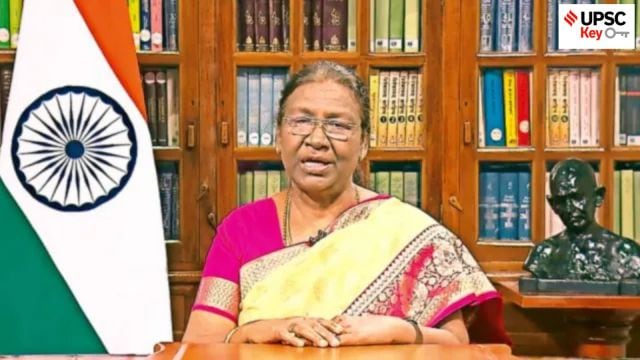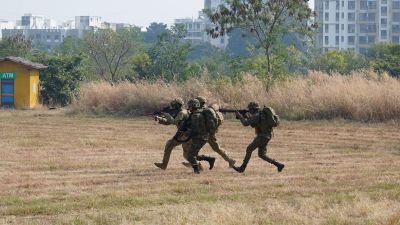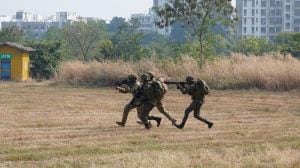
Preliminary Examination: Current events of national and international importance.
Main Examination: General Studies II: India and its neighbourhood- relations. Bilateral, regional and global groupings and agreements involving India and/or affecting India’s interests.
Story continues below this ad
General Studies III: Security challenges and their management in border areas – linkages of organized crime with terrorism.
What’s the ongoing story: JUST over 10 days after the Pahalgam terror attack that killed 26 people, India has ratcheted up its diplomatic offensive with a second set of measures against Pakistan: curbing water flow through the Baglihar dam; stopping the import of products; banning docking of Pakistan-owned ships and suspending the exchange of all mail and parcels.
Key Points to Ponder:
• What is the Indus Water Treaty? What is the issue associated with it?
• What are the various measures taken by the Indian government in the wake of the 2025 Pahalgam terror attack?
Story continues below this ad
• Why is cross-border terrorism a big cause of concern for India?
• Location of the Baglihar dam and the Sonmiani Ranges
• What are the major tributaries of the Indus Water System?
• What is the Abdali Weapon System?
• What are the benefits of the Most Favoured Nation (MFN) status?
Key Takeaways:
• The gates of the sluice spillways on the Baglihar dam have been lowered to restrict water flow to Pakistan’s Punjab as a “short-term punitive action,” a senior official told The Indian Express.
Story continues below this ad
• The Baglihar dam, over Chenab river, is designed as a run-of-the-river plant for hydro power generation. Chenab is one of the western rivers in the Indus Water system and the treaty allows for harnessing its waters for power generation.
• Pakistan tested its surface-to-surface ballistic missile with a 450-km range on Saturday. The missile, known as the Abdali Weapon System, was tested as part of its military drill “Exercise Indus.”
• Citing “cross-border linkages” to the April 22 attack, India has promised severe punishment to those involved in the strike.
• TO PLUG loopholes and eliminate any possibility of Pakistani goods entering its territory, the government has imposed an immediate ban on the import or transit of all goods originating in, or exported from, Pakistan, a May 2 notification of the Commerce and Industry Ministry said.
Story continues below this ad
• According to official data, India primarily exported items such as soya bean, poultry feed, vegetables, red chillies, plastic granules and plastic yarn, while importing dry fruits, dates, gypsum, cement, glass, rock salt and herbs from Pakistan.
• The curbing of trade marks a significant shift from the late 1990s, when India took the initiative to boost bilateral trade by extending Most Favoured Nation (MFN) status to Pakistan in 1996, leading to a surge in trading volumes. However, Pakistan never reciprocated by granting the same status to India.
• In 2019, India revoked Pakistan’s MFN status following the Pulwama terrorist attack.
Do You Know:
• The Indus Waters Treaty (IWT), which has survived four wars, decades of cross-border terrorism against India by Pakistan, and a long history of antagonism between the two countries, was suspended for the first time by New Delhi in the wake of the Pahalgam terror attack.
Story continues below this ad
• The IWT was signed in Karachi on September 19, 1960, following nine years of negotiations between India and Pakistan. The Treaty has 12 Articles and 8 Annexures (from A to H).
• According to the provisions of the Treaty, all the water of the “Eastern Rivers” of the Indus system — Sutlej, Beas and Ravi — shall be available for the “unrestricted use” of India. Pakistan shall receive water from the “Western Rivers” — Indus, Jhelum, and Chenab.
Other Important Articles Covering the same topic:
📍What India’s suspension of the Indus Waters Treaty means for Pakistan — and for itself
📍Indus River system and the debate on Indus Water Treaty
Previous year UPSC Prelims Question Covering similar theme:
Story continues below this ad
(1) With reference to the Indus river system, of the following four rivers, three of them pour into one of them which joins the Indus direct. Among the following, which one is such river that joins the Indus direct? (2021)
(a) Chenab
(b) Jhelum
(c) Ravi
(d) Sutaj
Previous year UPSC Mains Question Covering similar theme:
The scourge of terrorism is a grave challenge to national security. What solutions do you suggest to curb this growing menace? What are the major sources of terrorist funding? (2017)
Syllabus:
Preliminary Examination: Economic and Social Development-Sustainable Development, Poverty, Inclusion, Demographics, Social Sector Initiatives, etc.
Story continues below this ad
Main Examination: General Studies II: Welfare schemes for vulnerable sections of the population by the Centre and States and the performance of these schemes; mechanisms, laws, institutions and Bodies constituted for the protection and betterment of these vulnerable sections.
What’s the ongoing story: The government’s surprise announcement of a caste census as part of the upcoming population enumeration exercise may have dented the Opposition’s campaign but the experience of John Henry Hutton, an anthropologist-civil servant from nearly a century ago, frames the challenge on the road ahead.
Key Points to Ponder:
• What is a Census? Who has the power to conduct the census in India?
• What is the caste census?
• What is the role of the Census in social mobility?
Story continues below this ad
• How did the Census in the colonial period reshape the Indian Caste system?
• Analyse the potential of the caste census in mobilizing the caste in politics.
• What are the various arguments in favour and against the caste census?
• It has been alleged that the mere act of labelling persons belonging to a caste tends to perpetuate the system. — What do you understand by this?
Key Takeaways:
• Hutton, a Yorkshire-born, Oxford-trained officer who as Census Commissioner of India conducted the 1931 Census, the last to tabulate data on caste, writes with a hint of annoyance that the exercise “had the misfortune to coincide with a wave of non-cooperation, and the march of Mr. Gandhi and his contrabandistas…”.
• On the complexities of counting caste, his census report, laced with insight and wit, refers to former census chief Sir Herbert Risley, whose formulation of the caste system as a racial hierarchy in the 1901 Census laid the basis for subsequent surveys and policies on caste.
• Among the many challenges the census officials faced as they asked people to identify their caste was “misrepresentation” and people used the data collection exercise to jostle for a higher spot on the social order. The census also offered examples of multiple castes consolidating into a single caste for bolstering their numbers or claiming a new social status.
• “The best instance of such a tendency to consolidate a number of castes into one group is to be found in the grazier castes which aim at combining under the term ‘Yadava’ the Ahirs, Goalas, Gopis, Idaiyans and perhaps some other castes of milkmen, a movement already effective in 1921,” the report said.
• Despite the complexities the exercise involved, the anthropologist in Hutton recorded the social benefits of counting caste. Addressing the criticism “for taking any note at all of the fact of caste”, he wrote, “It has been alleged that the mere act of labelling persons belonging to a caste tends to perpetuate the system… It is, however, difficult to see why the record of a fact that actually exists should tend to stabilize that existence.
• Recent scholarship, including Nicholas B Dirks’s Castes of Mind (2001), has, however, argued that under colonialism, caste became a “single term capable of naming… subsuming India’s diverse forms” and that census operations such as Hutton’s reinvented and essentialised caste – rather than simply capturing what was already there.
• In the 1951 Census, in a newly Independent India shaped by the ideals of equality and secularism, the government led by Jawaharlal Nehru decided there would be no caste enumeration.
Do You Know:
• The data collected in Censuses since 1951 include the numbers of individuals belonging to the Scheduled Castes (SCs) and Scheduled Tribes (STs), and of various religious denominations. But the members of caste groups other than SCs and STs have not been counted.
• The most recent caste data available is from the Census of 1931. The 1941 Census, carried out during the War, collected data on caste, but they were never released.
• Ahead of the first Census of independent India, the government chose to avoid the question of caste. Thereafter, demands for a caste census were repeatedly raised, especially by parties who had a base among Other Backward Classes (OBCs), primarily farming communities and artisans.
Other Important Articles Covering the same topic:
📍The last caste census was in 1931. A look back at its findings
📍Explained: Demands for a caste census, and what happens now after its approval
UPSC Prelims Question Covering similar theme:
(2) Consider the following statements: (2009)
1. Between Census 1951 and Census 2001, the density of the population of India has increased more than three times.
2. Between Census 1951 and Census 2001, the annual growth rate (exponential) of the population of India has doubled.
Which of the statements given above is/are correct?
(a) 1 only
(b) 2 only
(c) Both 1 and 2
(d) Neither 1 nor 2
EXPRESS NETWORK
Syllabus:
Preliminary Examination: Indian Polity and Governance – Constitution, Political System, Panchayati Raj, Public Policy, Rights Issues
Mains Examination: General Studies-II: Functions and responsibilities of the Union and the States, issues and challenges pertaining to the federal structure, devolution of powers and finances up to local levels and challenges therein.
What’s the ongoing story: Underlining the significance of mediation in resolving conflicts, President Droupadi Murmu Saturday called for effectively extending the dispute resolution mechanism under the Mediation Act, 2023 to rural areas so that the panchayats are legally empowered to mediate and resolve conflicts in villages.
Key Points to Ponder:
• What is the Mediation Act, 2023?
• What is the significance of Mediation?
• What are the Gram Nyayalayas?
• How can mediation help in reducing the pendency of cases?
• What are the various Alternative Dispute Resolution Mechanisms?
• What are the dispute resolution mechanisms at the gram (village) level?
• What are the key features of the Mediation Act, 2023?
Key Takeaways:
• Addressing the ‘Launch of Mediation Association of India and 1st National Mediation Conference, 2025’, the President said that “we should see effective dispute and conflict resolution as not merely a legal necessity but a societal imperative”.
• India has a long and rich tradition of judicial mechanisms in which such out-of-court settlements were more of a norm than exception, she said, adding that the institution of panchayat is legendary for fostering amicable resolutions.
• She said that mediation fosters dialogue, understanding and collaboration, which are essential for building a harmonious and progressive nation. It will lead to the emergence of a conflict-resilient, inclusive and harmonious society, she said.
• Underlining the importance of mediation, the CJI said that it seeks to identify and remedy the root cause, goes deeper into the issue, and addresses primordial and underlying concerns that are the cause of the dispute. “It allows for a more holistic solution,” he said.
Do You Know:
• According to the India Justice Report 2025 in the judiciary, there is a 20 per cent increase in pending cases, crossing the five-crore mark; shortages in court halls; vacancies in the high courts and district courts that stand at 33 per cent and 21 per cent respectively.
• There is an increase in the average workload in district courts – 2,200 cases per judge, while case clearance rate is at 94 per cent. This leads to a slower pace of justice and erodes public confidence in the justice system.
• On legal aid, the report flags concerns over optimal utilisation of funds, uneven human resource deployment and shrinkage in community-based legal aid services like village legal services clinics (one clinic for 163 villages). The legal aid workforce includes 41,553 lawyers and 43,050 paralegal volunteers.
Other Important Articles Covering the same topic:
📍Knowledge Nugget: Why is the India Justice Report 2025 important for UPSC?
📍Role of Panchayati Raj in strengthening local governance
Previous year UPSC Prelims Question Covering similar theme:
(3) With reference to Lok Adalats, which of the following statements is correct? (2010)
(a) Lok Adalats have the jurisdiction to settle the matters at the pre-litigation stage and not those matters pending before any court
(b) Lok Adalats can deal with matters which are civil and not criminal in nature
(c) Every Lok Adalat consists of either serving or retired judicial officers only and not any other person
(d) None of the statements given above is correct
Previous year UPSC Mains Question Covering similar theme:
Assess the importance of the Panchayat system in India as a part of local government. Apart from government grants, what sources the panchayats can look out for financing developmental projects?
Syllabus:
Preliminary Examination: Current events of national and international importance
Mains Examination: General Studies-III: Disaster and Disaster Management
What’s the ongoing story: Goa Chief Minister Pramod Sawant said a magisterial inquiry has been ordered into the stampede that took place around 2.45 am during the annual jatra (festival) at Lairai Devi temple in Shirgao village.
Key Points to Ponder:
• Read about the significance and temple architecture of the Lairai Devi temple
• What is a stampede?
• What are the factors leading to stampedes?
• What are the NDMA guidelines for crowd management in India?
• What should be done for effective crowd management and preventing stampedes?
Key Takeaways:
• While police said adequate measures were taken for the festival, which is attended by thousands of devotees, including those from neighbouring states, eyewitnesses blamed the stampede on crowd mismanagement.
• The festival includes a fire-walking ritual [Agnidivya] during which the Dhonds circle a fire pit and walk barefoot across burning embers. The ritual draws large crowds.
• “During jatra, the sentiments are heightened and religious fervour is high. The Dhonds are fasting for days and often there is a competition to race ahead. In such a situation, if someone falls, they cannot get up. And this is what happened,” said Kauthankar.
• “The police personnel and ambulances were stationed quite a few metres apart, which delayed aid to the injured. Police should have released the crowd in phases. There was no crowd management.”
Do You Know:
• According to the Goa Tourism website, the Lairai Mandir in Sirgao displays a combination of the northern and southern styles of art and temple design. The Shirgao Jatra is famous among devotees and tourists alike for the celebrated walk on hot coals raked from an enormous bonfire.
• The Jatra takes place in early part of May, when thousands of devotees of Devi Lairai descend on the small town and religious rituals and poojas dedicated to the Goddess are performed throughout the auspicious day.Hundreds of people from the villages in surrounding areas also take part in these celebrations. Groups of these villagers from villages such as Maulingem, arrive in the early morning hours and participate in events throughout the day.
Other Important Articles Covering the same topic:
📍UPSC Issue at a Glance | How to prevent stampedes at mass gatherings — 4 Key Questions You Must Know for Prelims and Mains
Previous year UPSC Mains Question Covering similar theme:
Discuss the recent measures initiated in disaster management by the Government of India departing from the earlier reactive approach. (UPSC CSE 2020)
Syllabus:
Preliminary Examination: Current events of national and international importance
Mains Examination: General Studies-I: Social empowerment, communalism, regionalism & secularism.
General Studies II: Constitution of India —historical underpinnings, evolution, features, amendments, significant provisions and basic structure
General Studies III: Role of external state and non-state actors in creating challenges to internal security.
What’s the ongoing story: A statewide shutdown and mass gatherings marked the second anniversary of the ethnic clashes between the Meitei and Kuki-Zo communities of Manipur on Saturday. Shutdowns, observed in both the Meitei-majority Imphal Valley and the Kuki-Zo-dominated hill districts, brought life to a grinding halt across the state.
Key Points to Ponder:
• What are the causes of violence in Manipur?
• Understand the ethnic conflict in Manipur
• What is the conflict around the inclusion of Meities in the ST list?
• What is the process of inclusion in the ST list?
• What are the major tribes of Manipur?
• What are the other challenges faced by Manipur?
• What are the steps taken by the government to normalize the situation in the state?
Key Takeaways:
• While the Coordinating Committee on Manipur Integrity (COCOMI) enforced the shutdown in the valley, the Zomi Students’ Federation (ZSF) and the Kuki Students’ Organisation (KSO) led similar actions in the hill areas.
• In Churachandpur, thousands of Kuki-Zo residents gathered at the ‘Wall of Remembrance’ in Tuibuong to observe ‘Separation Day’, marking their community’s continuing demand for a separate administrative arrangement.
• The last major cycle of violence between the two communities took place in November last year, and a major political development took place earlier this year with the resignation of Chief Minister N Biren Singh in February, followed by the imposition of President’s Rule. However, “normalcy” remains a far cry for the state’s residents.
Do You Know:
• Right now, Manipur is under the President’s Rule after the resignation of Manipur Chief Minister N Biren Singh on February 9.
• The imposition of President’s Rule under Article 356 effectively transfers all the functions of the state government to the Centre and the function of the state legislature to Parliament during the period when it is in force. The only exception to this is the functioning of High Courts, which remains unchanged.
• Manipur’s Kuki-Zomi people — who live primarily in the districts of Churachandpur, Pherzawl, and Kangpokpi, with scattered populations in Chandel and Tengnoupal — come under the larger umbrella of the Zo ethnic tribes, one of the largest of which are the Lushei of Mizoram.
• The Zo peoples include all tribes of the Chin-Kuki-Mizo ethnic group spread across Myanmar, India, and Bangladesh, along with many sub-tribes and clans such as the Chin, Kuki, Mizo, Lushei, Zomi, Paitei, Hmar, Ralte, Pawi, Lai, Mara, Gangte, Thadou, etc.
Other Important Articles Covering the same topic:
📍Ethnicity, religion, a shared history: ties that bind the Zo peoples of Manipur & Mizoram
📍Government of India has the wrong approach in Manipur. Here’s what it needs to do
UPSC Prelims Question Covering similar theme:
(4) Consider the following pairs: (2018)
| Tradition |
State |
| Chapchar Kut festival |
Mizoram |
| Khongjom Parba ballad |
Manipur |
| Thang-Ta dance |
Sikkim |
Which of the pairs given above is/are correct?
(a) 1 only
(b) 1 and 2 only
(c) 3 only
(d) 2 and 3 only
ECONOMY
Syllabus:
Preliminary Examination: Economic and Social Development – Sustainable Development, Poverty, Inclusion, Demographics, Social Sector Initiatives, etc.
Mains Examination: General Studies-III: Indian Economy and issues relating to planning, mobilisation, of resources, growth, development and employment.
What’s the ongoing story: US President Donald Trump’s ‘Liberation Day’ reciprocal tariff announcements have created uncertainty for countries and businesses. With US trade partners scrambling to strike bilateral treaties that may ease their tariff burden and bridge their trade imbalance with America, companies are broadly choosing to keep their powder dry and watch what they say even if their first quarter earnings gave them something to cheer about.
Key Points to Ponder:
• What is the difference between a tariff and a tax?
• Why has America imposed reciprocal tariffs?
• What is the current status of India and America?
• What is the impact of a reciprocal tariff on various sectors?
Key Takeaways:
• In the Mobility sector, Swedish-origin, Chinese-owned carmaker Volvo withdrew its revenue forecast for the next two years, providing market watchers a window into the uncertainties that engulf the European car maker. Volvo Cars foresees an impact to its profitability arising out of “tougher market conditions and lower volumes combined with increased price pressure and tariff effects,” it said in its quarterly earnings report.
• German carmaker Volkswagen’s sports car brand Porsche reported better than expected earnings in the first quarter of the current fiscal from the North American region excluding Mexico.
• Danish beermaker Carlsberg kept its full-year outlook unchanged but warned that US tariffs are likely to affect consumer spending and the cost of raw materials in upcoming quarters.
• Energy major BP reported a 4 per cent decline in Q1FY25 net profit to $1.4 billion citing weaker refining and trading in gas.
Do You Know:
• Russian oil flows to India touched a 9-month high in April primarily due to the abundant availability of Moscow’s crude for exports as well as the low oil prices, with the latter ensuring sufficient number non-sanctioned tankers to haul the oil to Indian ports without falling foul of international curbs.
• April also saw India’s oil imports from the United States rise to an eight-month high, evidently on account of strategic trade considerations amid the evolving geopolitical and geoeconomic scenario.
• Tariffs are taxes or duties imposed by a government on imported goods and services. Their objective is to make foreign products more expensive compared to domestically produced goods, thereby encouraging consumers to prefer local products. Tariffs also act as a protective measure for domestic industries against foreign competition. Additionally, they serve as a source of revenue for the government.
Other Important Articles Covering the same topic:
📍India’s Russian oil imports at 9-month high in April; uptick in US crude volumes
📍UPSC Issue at a Glance | From Trump’s reciprocal tariffs announcement to 90-day pause: Everything in between
Prelims Question Covering similar theme:
(5) Consider the following statements:
1. Tariffs are taxes or duties imposed by a government on imported goods and services.
2. Objective of tariffs is to make foreign products more expensive compared to domestically produced goods
Which of the statements given above is/are correct?
(a) 1 only
(b) 2 only
(c) Both 1 and 2
(d) Neither 1 nor 2
| ALSO IN NEWS |
| India to benefit from China Plus One Strategy |
“China Plus One” strategy refers to businesses diversifying their operations beyond China, often while still maintaining a presence there. India has been trying to be at the forefront to gain from this strategy by pursu- ing a bilateral trade agreement (BTA) with the US, a free trade agreement with the UK and the EU. “China Plus One, which was a different dimension earlier, now acquires a much higher sense of urgency for many of the companies located inside China,” Nageswaran said at Ashoka University’s Annual Growth Conference 2025. |
| Angola President condemns ‘heinous, cowardly act’ during visit to New Delhi; Modi announces $200 million defence credit line for Angola defence force modernisation |
Several MoUs were signed between the two countries in the fields of traditional medicine, agriculture, and cultural cooperation during Lourenco’s visit. Modi said India will also share its capabilities with Angola in the areas of digital public infrastructure, space technology and capacity building. Angola has also signed up for the International Solar Alliance (ISA) Framework Agreement initiated by India |
| PRELIMS ANSWER KEY |
| 1. (a) 2. (d) 3. (d) 4. (b) 5. (c) |
Subscribe to our UPSC newsletter. Stay updated with the latest UPSC articles by joining our Telegram channel – IndianExpress UPSC Hub, and follow us on Instagram and X.
🚨 Click Here to read the UPSC Essentials magazine for April 2025. Share your views and suggestions in the comment box or at manas.srivastava@indianexpress.com🚨


































